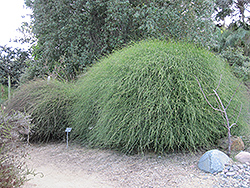It's all about ...
plants

Height: 10 feet
Spread: 12 feet
Sunlight:
![]()
Hardiness Zone: 8b
Other Names: Horsetail, Vining Horsetail
Description:
An interesting climbing shrub with dark green, wiry, leafless branches that grow upward, then arch outward from a thick, fissured trunk; an impressive cascading, fine textured focal plant; may grow higher with support
Ornamental Features
Tramontana features subtle bracted gold flowers along the branches in mid spring. It has emerald green evergreen foliage. The grassy leaves remain emerald green throughout the winter. It produces white berries in mid summer.
Landscape Attributes
Tramontana is a dense multi-stemmed evergreen shrub with a rounded form and gracefully weeping branches. It lends an extremely fine and delicate texture to the landscape composition which can make it a great accent feature on this basis alone.
This is a relatively low maintenance shrub, and is best pruned in late winter once the threat of extreme cold has passed. It has no significant negative characteristics.
Tramontana is recommended for the following landscape applications;
- Accent
- Rock/Alpine Gardens
- General Garden Use
Planting & Growing
Tramontana will grow to be about 10 feet tall at maturity, with a spread of 12 feet. It tends to fill out right to the ground and therefore doesn't necessarily require facer plants in front, and is suitable for planting under power lines. It grows at a fast rate, and under ideal conditions can be expected to live for approximately 30 years.
This shrub should only be grown in full sunlight. It is very adaptable to both dry and moist growing conditions, but will not tolerate any standing water. It is considered to be drought-tolerant, and thus makes an ideal choice for xeriscaping or the moisture-conserving landscape. It is not particular as to soil pH, but grows best in sandy soils. It is somewhat tolerant of urban pollution. This species is not originally from North America.
This plant is not reliably hardy in our region, and certain restrictions may apply; contact the store for more information.
